It's expected that AI in the educational market will grow at a CAGR of over 40% by 2027. This opens space for worthwhile investments and disruptive business ideas. Keep on reading to learn what challenges businesses solve with AI adaptive learning and how they can apply it to teach better and to earn more.
What is adaptive learning in education?
Adaptive learning is defined as an educational method where students get a personalized learning experience. Teachers use this approach to change the curriculum according to learners' needs. As a result, it helps students learn faster, easier, and more efficiently.
Imagine that you are in a classroom, struggling to understand a difficult topic. Your instructor will provide different hints based on your actions. For instance, they could shift the lesson's course, provide real-life examples, or even come up with another activity.
The teacher changes the class to help the student. It's a prominent example of adaptive learning in the classroom. However, the approach is only efficient when there are a few learners. Providing an individualized learning path for a big group at once is nearly impossible for one instructor. That's where AI for education makes an entrance.
If we speak of AI-powered e-learning software development, the number of students may be limitless. AI algorithms analyze the way a learner studies. Based on the information they get, the algorithms start showing customized content.
For example, if you make a mistake in the same task more than once, the program will provide similar assignments, explanations, and related materials. So instead of moving to a new topic, you'll have to correct your mistakes. This will help you understand the subject better. Teachers already apply the technology by implementing AI in K-12 education.
Who can learn with adaptive learning technologies?
The main feature of adaptive learning is that it makes the learning process suitable for everyone. It doesn't matter whether the learner is a K-12 pupil, university student, corporate employee, or anyone else. The technology adapts the material according to your knowledge.
AI-powered adaptive learning can be applied in any learning area like:
- Languages;
- Economy;
- Science, and others.
The field of study doesn't matter. Artificial intelligence and machine learning can amplify the results of any educational process. That's the benefit of EdTech!
5 ways how AI-powered adaptive learning solves educational challenges
Artificial intelligence implemented in LXP, LMS, TMS, or other eLearning applications solves multiple educational challenges, for example, through custom LMS development. You will find a detailed explanation below.
1. Saves training resources to minimize the budget.
People learn faster when they are mentored. In fact, 97% of mentees find this approach undoubtedly valuable. However, you can't hire one for each employee in a big corporation. That would lead to huge expenses. Adaptive learning maximizes your training resources.
By analyzing all available data, the software provides relevant materials and tasks for each employee. The technology literally adapts the program to their needs. You could think of it as a personal digital mentor.
2. Enhances knowledge retention to improve learners' long-lasting skills.
If you don't apply your knowledge for a long time, it constantly moves to a passive state. The same goes for your employees. They are unlikely to remember all the training and courses you've made them complete.
Adaptive learning ensures your team is ready to handle any issue whenever it appears. The technology constantly analyzes what the learners remember, detecting knowledge gaps and providing appropriate recommendations. Thus, they are always ready to solve any problem.
3. Boosts learners' engagement to help create a continuous learning culture.
A traditional course would force all employees to follow the same curriculum. Everyone has got a different experience, meaning that some people from your team might find more than half of the course as a waste of time. You can't make the whole company study the same material – it's just ineffective.
AI-based adaptive learning helps each employee get engaged in the studying process. There aren't any monotonous tasks that can be copied from the Internet. Instead, each member completes a unique path to enhance their skills. Take a look, for example, at how a Learning Experience Platform works.
The software will continuously assess the learner to detect their weaknesses and, consequently, remove knowledge gaps. This will keep your team focused on important activities.
As a result, employees increase their qualifications, and companies get more competent specialists.
4. Increases time efficiency to reduce training time.
E-learning takes 40-60% less time than the traditional classroom. By adding adaptive learning technologies, your employees start to use the time for education more efficiently. The course content is being adapted to the learner, skipping the material you already know.
5. Performs deep analytics to track training efficiency and learners' performance.
Training managers can get metrics that show each employee's progress. It's an excellent addition to track their success, understand strengths and weaknesses, and also provide a better learning experience. By the way, AI in talent management is another common use case!
It's time to develop your eLearning software! Let's discuss your project now!
What is an example of AI-powered adaptive learning in education?
Many applications apply adaptive learning in education.
Duolingo
Duolingo combines machine learning and adaptive learning in artificial intelligence to provide a better experience for all users. This app is focused on language learning through gamification and adaptivity.
The software tracks various information like:
- The number of times you've seen a word;
- Your mistakes in specific topics;
- The topics and phrases you know best.
It uses AI to predict the probability a learner would recall a word in the given context. The technology also calculates how much the student should practice to memorize the material as much as possible.
So that you'd understand the speed at which Duolingo “learns” from your interactions, here's an example.
When you open the app for the first time, you'll be asked to complete a placement test. All questions are based on your previous answers. It takes less than five minutes for the system to determine your language level.
If you've had four years of English at the university, you don't have to start from scratch. Show your language level and enjoy the tasks!
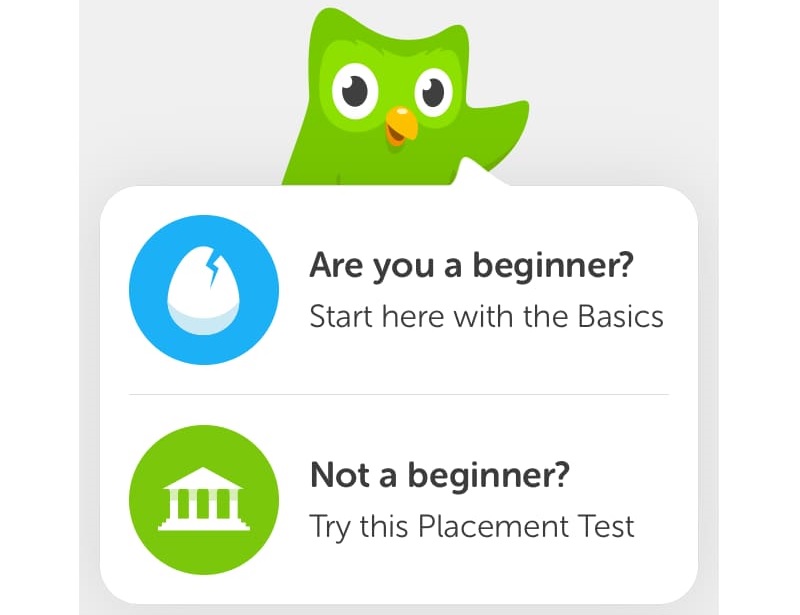
Prodigy Math
Another adaptive and gamified learning app is Prodigy Math. Again, students see the recommended content that is completely based on an adaptive algorithm. It is capable of detecting the learner's strengths and weaknesses to provide a better learning environment.
As a result, students get the following:
- Content that is challenging enough to develop new skills and abilities;
- To-the-point tasks that help them apply previous knowledge.
The best part is that learners don't even understand that their answers are being estimated because there is an absence of traditional assessment interfaсes. All assessment work is being done behind the scenes. Prodigy Math applies its adaptive algorithm to provide personalized tasks. It always works in the background, making calculations and predictions.
Imagine that there is a student who attempts to master a new skill. They pass 10 questions, and each is correct. The algorithm assumes that material is acquired, so it provides new topics that are a bit more challenging. It is even possible to get content designed for a higher grade, thus continuing the learner's development.
Now let us look at another student. They want to master the same skill, but there are several mistakes in their answers. This results in the algorithm assuming the learner is struggling with the topic. Thus, before the skill is mastered, the student must complete a different pathway with more questions and explanations.
That's how AI helps people get an individual experience.
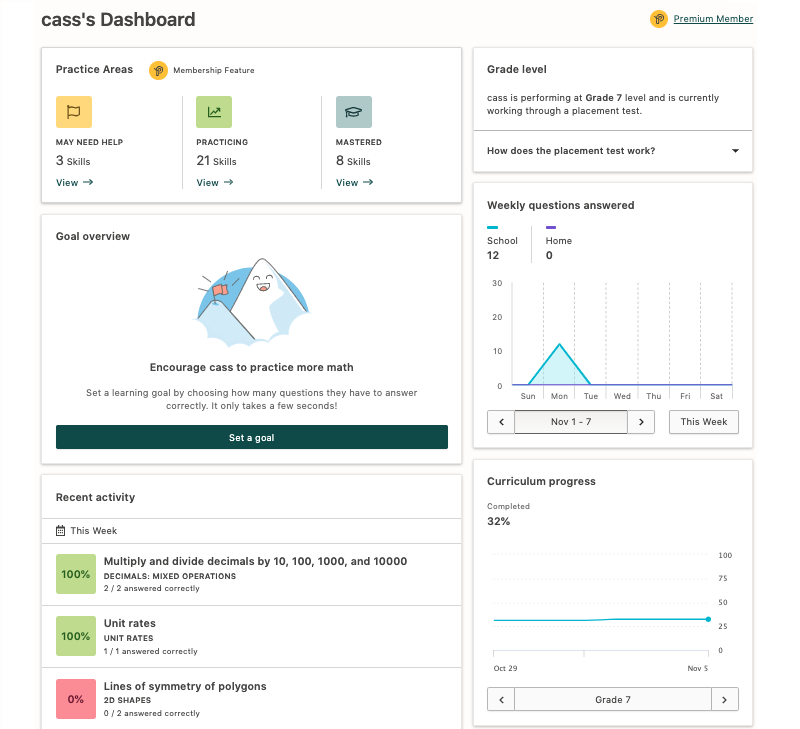
Embibe
Embibe combines AI and data science to help K-12 learners prepare for exams and fill in knowledge gaps. It's very similar to the uplisted two apps because it also uses diagnostic tests, analyzes the students current level, and helps them fix learning gaps.
Artificial intelligence gives its users the following:
- Personalized guidance;
- Tasks and materials to improve current grades;
- Theory extracts in the form of hidden tips explain why a learner struggles with a specific topic.
Thus, anyone can enhance their knowledge with this technology. It provides relevant explanations and assists learners on their path.
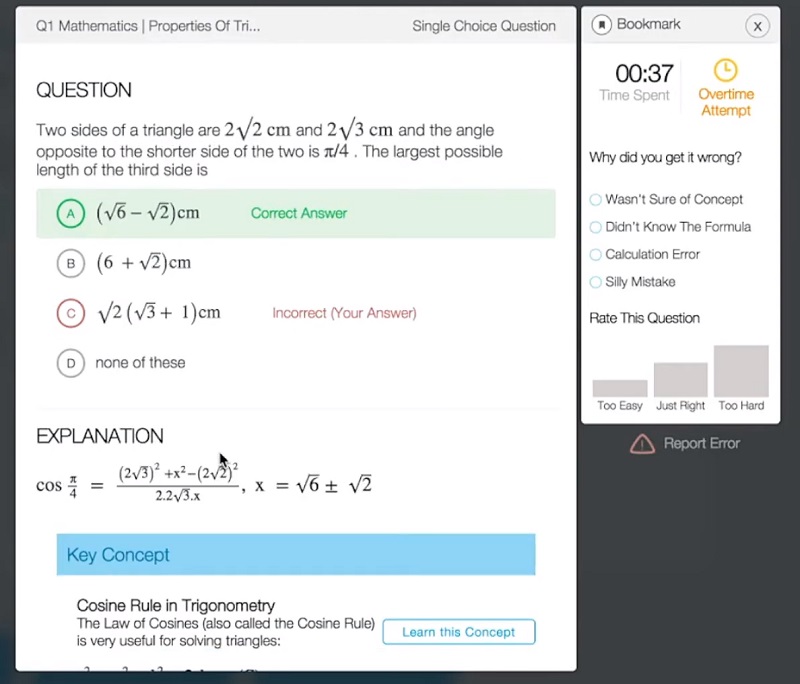
Lexia PowerUp
Lexia PowerUp is an adaptive blending learning application designed to help struggling learners increase their literacy skills from grades 6-12. The software uses placement tests to determine which programs and assignments the student should complete.
For example, if the child struggles with a task too long, the app will provide hints and solutions. They are available both in text and audio format.
Adaptive learning technologies help students:
- Determine their current knowledge level;
- Get a personalized learning pathway;
- Get adaptive instructions throughout the process.
Lexia PowerUp combines adaptive technologies with fun ways to engage learners. Apart from personalized instructions, they also get humorous videos, elements of gamification, and self-monitoring tools.
If you pay close attention, you'll see that the only differences in each app are the number of features, target audiences, and learning areas. The best platforms always attempt to apply gamification in the learning process because it increases engagement, development and boosts memorization.
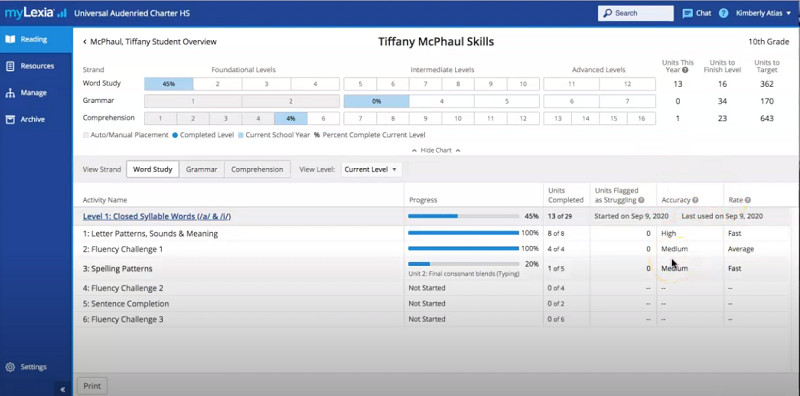
Interested in creating an AI-based adaptive learning solution? Contact us to learn more!
How does adaptive learning AI work?

The adaptive learning technology in education works based on the following three steps:
- Assessing the learner's knowledge. The system gathers data from the whole course or separate modules. Then, it calculates the student's mistakes, weaknesses, and strong points.
- Providing targeted content. After analysis, the software recommends the user to read different materials, complete assignments, or proceed to the next module. Everything depends on the results of the assessment.
- Interacting with feedback data at all times. An adaptive model constantly monitors all processes. So, for example, if a user struggles with a particular task, AI will provide different variations of the topic in the next assignments.
One of the common use cases of AI in education is the integration of AI in an LMS to get better insights into the whole process. Not only does it provide personalized content for learners, but it also gives you an understanding of which topics need more focus. The system applies multiple algorithms to figure out how to meet the student's needs.
What is adaptive machine learning?
Adaptive machine learning is a technique that needs human assistance only when it matters most. It is capable of learning autonomously as long as new data is provided.
Adaptive ML represents the 4th generation of machine learning.
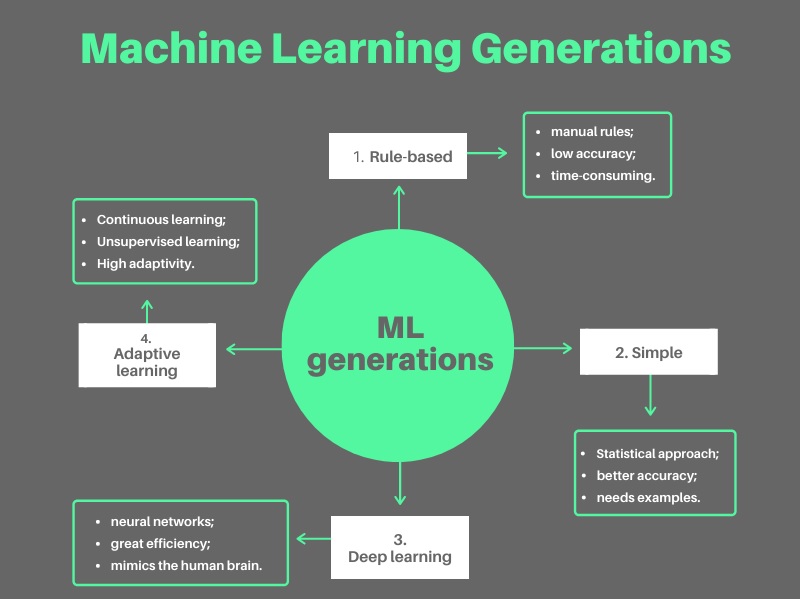
1st generation: rule-based machine learning
Rule-based ML works based on rules created manually by people. Let’s suppose that a software developer created a rule that “Ford” followed by “Focus” would mean a car, while preceded by “Harisson” would mean a person. It would help the software identify whether the text is about a car or a human.
The key disadvantage of this approach is manual work that can't cover all existing rules for each word and phrase. The process is very time-consuming and lacks accuracy.
Even if a specialist managed to add all the words and phrases they could think of, new contexts and meanings would still appear. The world is changing rapidly, so it is necessary to have a time-efficient method.
2nd generation: simple machine learning
Simple ML works based on statistics. So, for example, if a sentence includes the word “Ford” that is already labeled as a car, it will automatically assume that “Focus” as the following word is enough contextual evidence.
While the statistical approach makes this generation faster and more accurate, its efficiency depends on the number of labeled data for supervised learning. Thus, you need a lot of examples to make this ML generation work properly.
3rd generation: deep learning
Deep learning is based on neural networks with multiple layers, almost like a human's brain. For example, the algorithm gets raw data, and it makes a decision of its own whether the info is relevant. The more data it acquires, the more efficient it becomes.
It is extremely close to mimicking a human's mind. Deep learning creates patterns, detects objects, and makes decisions, all based on former experience. Also, the system may be taught through raw data that may remain unlabeled.
4th generation: adaptive learning
Adaptive machine learning combines the best features of all ML generations and learns continuously. This algorithm may also use unsupervised machine learning, which makes it stand out even more.
As we have already mentioned, adaptive ML will always be up-to-date because of its nature. The system isn't tied to one specific feature. It can adapt and survive in changing conditions.
How are traditional ML and adaptive ML different?
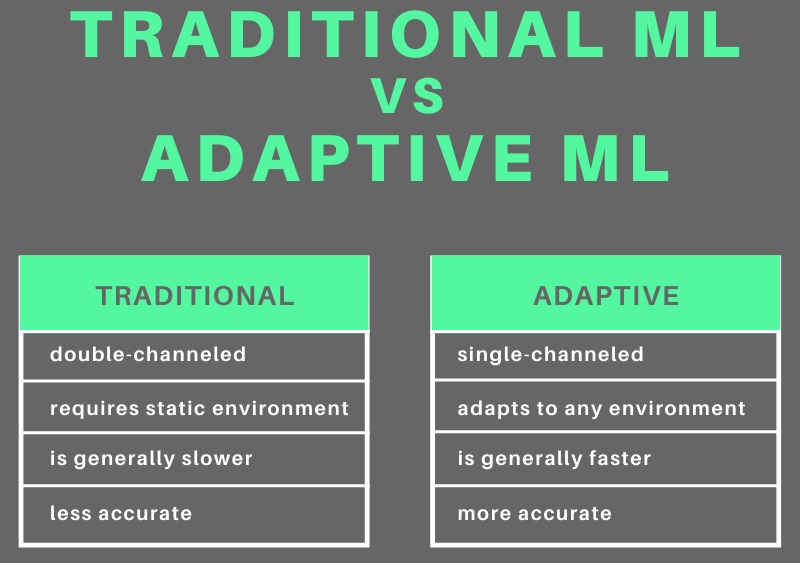
The first difference between these types of machine learning is that traditional ML has two channels. One is used for training, the other for predictions. Because of this separation, the process takes a lot of time.
An adaptive system is single-channeled. It gathers data and learns at the same time, making the whole process much faster. That's why it is considered to be superior.
The second difference is that traditional ML is based on a static environment. If we apply some changes to it, we might encounter some serious errors. Changing the system's behavior requires a lot of resources.
Adaptive machine learning is based on its main feature – adaptability. It doesn't matter whether the environment is static or constantly changing. The system can change its behavior without involving losses and applying outdated info.
The last point is that adaptive ML, unlike its traditional counterpart, can learn from its former data. The more data it acquires, the better it works. Additional knowledge helps the system be more accurate with its predictions and avoid mistakes.
What are the types of machine learning algorithms?
Machine learning applies different algorithms to get new data, process it, and make decisions.
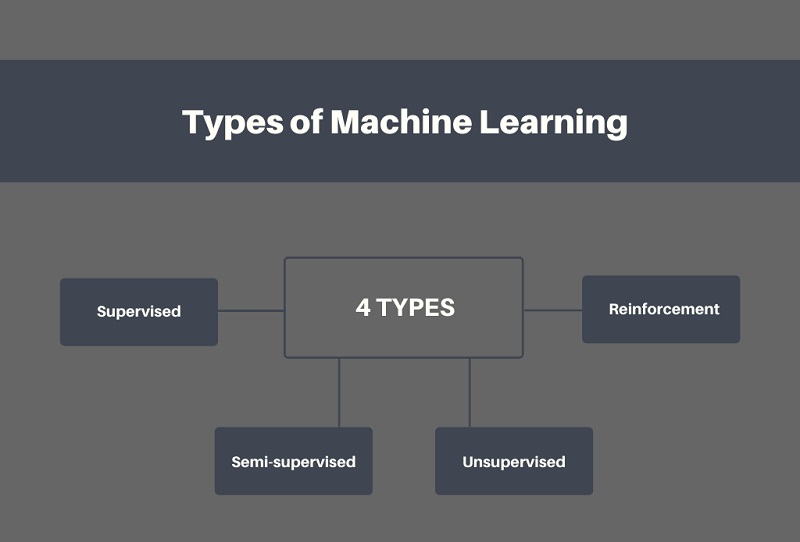
Supervised learning
Supervised learning means machines are taught by examples. For instance, people provide a number of processed data with their desired inputs and results. Then, the algorithms search for patterns and similarities to make predictions.
Human supervision is required to correct the machine when it makes a mistake. The whole process lasts until the machine gets a high level of accuracy.
Semi-supervised learning
Semi-supervised learning applies examples with both processed and raw data. The general idea is that the machine learns from the labeled information and applies the knowledge to label raw data.
Unsupervised learning
Unsupervised learning teaches the machine to find patterns without human intervention. No answers or hints are provided. The machine groups data into various categories based on its analysis. The more data is processed, the easier it is to make an accurate decision.
Reinforcement learning
Reinforcement learning provides the machine with rules and required results. The algorithm then analyzes all existing options to find the optimal result.
It's a complex sequence of decisions that make the machine apply former experience. That's how adaptive machine learning works.
What are adaptive learning AI tools?
We may divide adaptive learning tools into two categories.
- Simple. This type applies a linear model to determine a learner's progress. For example, a correct answer will take you to Point 1, while a wrong answer will result in Point 2. It is the very foundation of personalization. The only drawback is that the user constantly follows a predefined route, which isn't complete adaptivity.
- Complex. This type uses different data to show appropriate content. For instance, it could track previous answers, a number of interactions, current situations, and many complex conditions. The core is AI's inference engine that applies logical rules to make assumptions.
Adobe Captivate is an example of an adaptive learning tool that may be placed in the “simple” category. It helps instructors to create branched scenarios. While this is the basic version of course adaptation, a complex solution does this task far better. However, a complex adaptive learning tool needs a skilled development team.
The future of adaptive learning in education
It is expected that the global corporate e-learning market will cost $50 billion by 2026. That's not a surprise, with more than 90% of corporations using these technologies to teach their employees. Increasing one's qualification is even possible via a smartphone. Combine this with adaptive learning, and it will be no wonder people become more engaged in corporate training.
The general e-learning market is projected to reach $243 billion by 2022. This is because forced distance education boosted the whole industry, driving the implementation of new technologies. And, of course, adaptive learning is among the leading positions.
We can see AI in higher education, K-12 classes, corporate training, online courses, and any other field related to studying. It is suitable for all areas and ages.
A report from 2017 stated that AI and machine learning in the US educational system would grow 47,5% by 2021, and we can already reap the benefits. Everyone strives toward personalization and real-time feedback. Most teachers also see it as an optimal solution to improve education. So it's the perfect time to invest in AI-based EdTech!
Do you want to get AI-based adaptive learning technologies in your software? How about creating an e-learning platform from scratch? We'll help you make the right choice. Let's talk!
Rate this article
Recommended posts
Portfolio

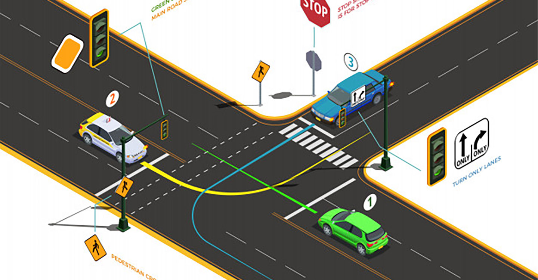
Our Clients' Feedback






















.jpg)
.jpg)
.jpg)
.jpg)
.jpg)
.jpg)
![Artificial Intelligence in Education [Ultimate Knowledge Hub]](/uploads/images/blog/posts/previews/image_163177848252-image(600x250-crop).jpg)
.jpg)
.jpg)
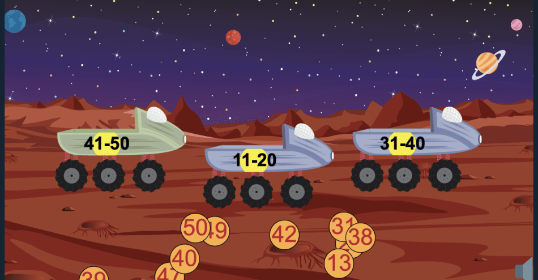















Belitsoft has been the driving force behind several of our software development projects within the last few years. This company demonstrates high professionalism in their work approach. They have continuously proved to be ready to go the extra mile. We are very happy with Belitsoft, and in a position to strongly recommend them for software development and support as a most reliable and fully transparent partner focused on long term business relationships.
Global Head of Commercial Development L&D at Technicolor